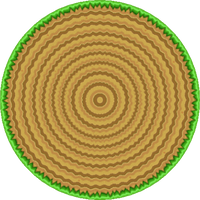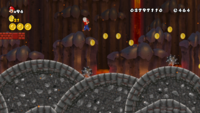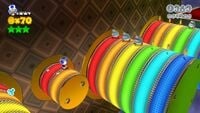Turning Floor
- "Rolling hill" redirects here. For the Mario vs. Donkey Kong: Tipping Stars world, see Rolling Hills.
It has been requested that more images be uploaded for this article. Remove this notice only after the additional images have been added. Specifics: Sprites/renders of Turning Floors in the 2D games, perhaps in a separate gallery
| Turning Floor | |||
|---|---|---|---|
 Model from New Super Mario Bros. Wii | |||
| First appearance | New Super Mario Bros. Wii (2009) | ||
| Latest appearance | Super Mario 3D World + Bowser's Fury (2021) | ||
| |||
| |||
Turning Floors[1] are continually moving objects that appear in platformers of the Super Mario franchise. They are large, circular or semicircular platforms that turn clockwise or counterclockwise, moving anything on them as they do so.
History[edit]
Super Mario series[edit]
This section is a stub. Please consider expanding it to include any missing information. Specifics: include all level appearances in New Super Mario Bros. Wii, New Super Mario Bros. U, and New Super Luigi U
New Super Mario Bros. Wii[edit]
New Super Mario Bros. Wii features Turning Floors of various sizes in World 1-1, World 1-6, World 6-2, World 6-![]() Airship, and World 8-2. They are partly embedded in the ground or overlapped with other Turning Floors. Often, there are rows of coins or Dash Coins that move along with them, and in common instances they also carry enemies such as Goombas, Paragoombas, Hefty Goombas, and Spike Balls. Some Turning Floors also contain indentations with Pipes embedded in them. Their function is a pun referencing rolling hills.
Airship, and World 8-2. They are partly embedded in the ground or overlapped with other Turning Floors. Often, there are rows of coins or Dash Coins that move along with them, and in common instances they also carry enemies such as Goombas, Paragoombas, Hefty Goombas, and Spike Balls. Some Turning Floors also contain indentations with Pipes embedded in them. Their function is a pun referencing rolling hills.
Through hacking methods, it is shown that Turning Floors lack collision from the bottom, and that jumping to the center of one of them will warp the player atop it. This feat can be performed in-game in World 1-6.[2]
The game features several similar obstacles such as cogs and fence wheels.
New Super Mario Bros. U / New Super Luigi U / New Super Mario Bros. U Deluxe[edit]
Turning Floors reappear in New Super Mario Bros. U, New Super Luigi U, and New Super Mario Bros. U Deluxe, acting in much the same way as previously. They are encountered in the levels Yoshi Hill and Blooming Lakitus in the former, and in Rolling Yoshi Hills and Spinning Sandstones in the latter.
Icy Turning Floors also appear in the New Super Mario Bros. U level Prickly Goombas! and its New Super Luigi U counterpart, Fire and Ice.
Super Mario 3D World / Super Mario 3D World + Bowser's Fury[edit]
In Super Mario 3D World, Turning Floors are most notably seen in Really Rolling Hills and its World Mushroom counterpart, where Skipsqueaks and Spiny Skipsqueaks will run opposite to the direction the Turning Floor is moving, keeping themselves centered on the platform. Other entities, such as Galoombas and items summoned from the item storage, will also move in the direction of the Turning Floor if they remain stationary.
Mario and other characters can progress by walking or running in the opposite direction, jumping forwards, or many times simply avoiding the platform altogether. However, fully circular, mandatory Turning Floors appear in Rainbow Run, along with Skipsqueaks. The direction and speed of Turning Floors varies greatly. Skipsqueaks do not appear to change their running speed to account for this, yet still appear on the center of the platform.
A very large, circular Turning Floor appears in the twenty-sixth room of Mystery House Marathon, where the character must stay on top of it as it moves to reach the Green Star at the end. Its design appears to be styled after Cookie Cogworks.
In the Bowser's Fury campaign of Super Mario 3D World + Bowser's Fury, hollow Turning Floors appear in Slipskate Slope, in segmented sections that move left and right. While Skipsqueaks are found on top of these platforms, inside are spikes that Mario must carefully avoid being pushed into while in an Ice Skate.
Captain Toad: Treasure Tracker[edit]
Turning Floors appear in all versions of Captain Toad: Treasure Tracker, appearing only in the level Rolling Inferno. They may be colored blue or green, but this is merely an aesthetic change, as their direction of rotation is indicated by chevron arrows imprinted on them. In part due to Captain Toad's inability to jump, once the player crosses a Turning Floor, they cannot move against it.
Unused appearances[edit]
In the kiosk demo of Mario Kart DS, a turning slot machine reel is located in the floor at the end of an early version of Waluigi Pinball, behaving much like a Turning Floor. An early version of Waluigi Pinball, still featuring the turning slot machine reel, is also hidden in the files of the final game under the donkey_course filename.
Names in other languages[edit]
| Language | Name | Meaning | Notes |
|---|---|---|---|
| Japanese | 回転足場[3] Kaiten Ashiba |
Rotating Footing | New Super Mario Bros. Wii |
| 回転床[4] Kaiten Yuka |
Rotating Floor | New Super Mario Bros. U | |
| Portuguese (NOE) | Relva Rotativa[5] | Rotating Grass |
References[edit]
- ^ "When you come across Turning Floors with coins and Goombas, plan your timing carefully and you'll do fine." – TheMarioBros.net (November 17, 2013). New Super Mario Bros U - Coin Collection Challenges w/ Gold Medals Complete [HD] (7:10). YouTube.
- ^ A+Start (June 30, 2017). New Super Mario Bros. Wii Glitches - Son of a Glitch - Episode 74. YouTube. Retrieved July 28, 2022.
- ^ Sakai, Kazuya (Ambit), kikai, Akinori Sao, Junko Fukuda, Kunio Takayama, and Ko Nakahara (Shogakukan), editors (2015). "New Super Mario Bros. Wii."『スーパーマリオブラザーズ百科: 任天堂公式ガイドブック』. Tokyo: Shogakukan (Japanese). Page 149.
- ^ ---- (2015). "New Super Mario Bros. U."『スーパーマリオブラザーズ百科: 任天堂公式ガイドブック』. Tokyo: Shogakukan (Japanese). Page 215.
- ^ Canal New Super Mario Bros. U (February 6, 2013). New Super Mario Bros. U - Desafios: As Moedas Proibidas dos Goombas-Picos (Wii U). YouTube (European Portuguese). Retrieved September 16, 2025.

